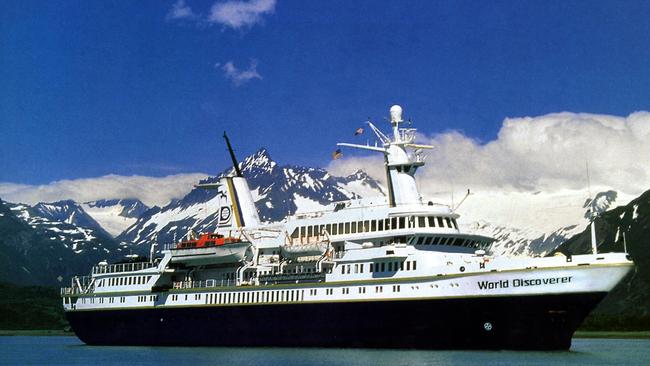Where are they now? The hidden histories of cruise ships
Passenger vessels change hands regularly, and there’s a complex set of maritime rules to follow to avoid sparking Poseidon’s wrath.

Cruise ships are built to last 30, 40 or more years and during their lifetimes they can take on a multitude of identities as they move between fleets. New owners change their names and livery, give them extensive (and expensive) refurbishments, and even “stretch” them to add more staterooms, bigger pools and better restaurants.
Some are repurposed and moved to a different fleet within the same company – for example, Silversea’s venerable Silver Wind and Silver Cloud. Between 2017 and 2020 the sister ships from the “classic” fleet were completely rebuilt with ice-strengthened hulls and polar technology to sail under the line’s luxury expedition banner. Their names, which reflect the original owner’s admiration of Rolls-Royce, didn’t change.
Last year, Silversea sold its oldest ship, Silver Explorer, to a new French line called Exploris, which will offer Antarctic expedition cruises as Exploris One from December this year. Built in 1989, the 144-guest ship has previously been known as Delfin Clipper, Sally Clipper, Baltic Clipper, Delfin Star, Dream 21, World Discoverer, World Adventurer and Prince Albert II – quite a roll call.

Luxury cruisers were devastated when the 2022 financial collapse of Crystal Cruises’ parent company Genting Hong Kong forced the sale of Crystal’s two ultra-luxe oceangoing ships, its expedition yacht and five state-of-the-art river ships. The vessels were snapped up and earlier this year Crystal Serenity and Crystal Symphony made a triumphant return with new owners Abercrombie & Kent; Crystal Endeavor became Silver Endeavour (Silversea anglicised the spelling to make it the same as James Cook’s famed Endeavour); and a new river cruise company, Riverside Luxury Cruises, bought the river ships. Within a matter of months, Riverside sold the former Crystal Bach and Crystal Mahler to Uniworld Boutique River Cruises, which is now renaming them SS Victoria and SS Elisabeth. They bring Uniworld’s fleet of highly individual, lavishly fitted-out Superships to 10 and will set sail in Europe next year.
Speaking of luxury, SeaDream Yacht Club’s twin “motoryachts”, SeaDream I and II – now aged 39 and 38 respectively – regularly score five-star ratings from cruise expert Douglas Ward, of Berlitz Guides fame. They started sailing as Sea Goddess I and II for Norway’s Sea Goddess Cruises, moved to Cunard in 1986 and a year later to Seabourn, which was co-founded by the ships’ current owner, Atle Brynestad. Seabourn Goddess I and II, as they were then renamed, left Seabourn in 2001 when Brynestad established SeaDream Yacht Club. In 2002 they were re-rechristened SeaDream I and II by Brynestad and his wife, Linn, in a joint ceremony off the coast of Corsica. Are you keeping up?

Meanwhile, Seabourn, which was bought out by the mammoth Carnival Corporation in 2001, went on to commission three new builds: Seabourn Pride, Seabourn Spirit and Seabourn Legend. The near-identical triplets made their maiden voyages in 1988, 1989 and 1992 – although Legend sailed for the now defunct Royal Viking Line and Royal Cruise Line as Royal Viking Queen and Queen Odyssey until 1996, for complicated financial reasons – and in 2015 all three were sold to Windstar Cruises.
Duly renamed Star Pride, Star Spirit and Star Breeze, the 212-passenger ships underwent a drastic “stretching” in dry dock between 2019 and 2020, an operation that reportedly cost Windstar about $US250m ($386m). Star Breeze was the first to undergo the four-month procedure, which involved the ship being chopped in half and having a new prefabricated section inserted in the middle, then welded back together.
The stretch added 25m to each ship’s length, bringing them to 159m. Fifty new suites apiece – including a lavish Grand Owner’s Suite – increased their capacity to 312 guests and, of course, increased Windstar’s bottom line. However, it wasn’t all about new suites and the “re-imagined” Veranda restaurant; Windstar also replaced engines with more environmentally friendly models and revamped the bathrooms in every suite. Sea Breeze is sailing her inaugural season Down Under this summer and however closely you look, you won’t find any post-op scars.

Seafarers are notoriously superstitious, and renaming a vessel of any type is said to bring bad luck. Given cruise ships regularly take on new identities, what should their owners be doing to prevent disasters? The main thing to remember is that according to maritime legend, when a ship is christened, its name goes into a Ledger of the Deep that’s kept by Poseidon, god of the sea. Renaming it means you’re trying to deceive Poseidon and he will take his revenge on the ship unless you appease him with an appropriate ceremony.
There are many variations of the renaming ceremony but in a nutshell, it’s about removing all traces of the vessel’s former name then rechristening it, traditionally with Champagne. Some should be offered to the water, some to each of the four wind gods (Boreas, Zephyrus, Eurus and Notus) and Poseidon should be asked to provide safe passage, fair winds and calm seas for future voyages. So now you know … maybe ask the captain of your next ship if he or she has done the right thing by the gods if you know it is already on its third or fourth name.

Another much-debated subject is how vessels are classified: do we call them ships, liners or boats? There are as many opinions about this as there are ships’ names, but the most popular interpretation is that it’s all about size: a ship can carry a boat, but a boat can’t carry a ship. One thing is for sure: cruise-ship captains are not impressed if you refer to their vessel, whatever its size, as a boat. An oft-repeated phrase I like is, “In the officers’ mess it is said, ‘A ship, gentlemen, is what we are in; a boat is what the gravy comes in’.” But don’t forget that in the world’s navies, a submarine is always called a boat.
As for that overworked term “luxury liner”, according to Cunard expert Chris Frame, Queen Mary 2 is the only true transatlantic ocean liner in operation today. Ocean liners are built to withstand a “line voyage” across a large expanse of open ocean and typically feature longer bows and stronger hulls than regular cruise ships and can reach higher speeds to (theoretically) outrun storms. Queen Mary 2’s top speed is just over 30 knots (56 km/h); the biggest cruise ship in the world, Royal Caribbean’s Wonder of the Seas, can make about 23.7 knots. I know which one I’d rather cross the Atlantic on.




